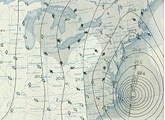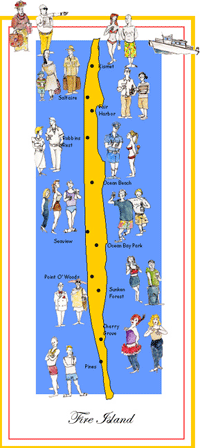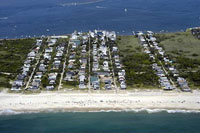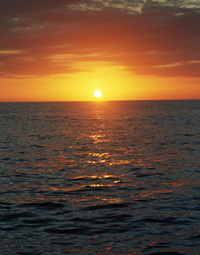
Weather map from September 21, 1938 featuring the storm
Formed -
September 9, 1938
Dissipated -
September 22, 1938
Highest winds
1-minute sustained:
160 mph (260 km/h)
Lowest pressure
940 mbar (hPa); 27.76 inHg
Fatalities
682 to 800 direct
Damage
$306 million (1938 USD)
The New England Hurricane of 1938 (or Great New England Hurricane, Yankee Clipper, Long Island Express, or simply the Great Hurricane) was the first major hurricane to strike New England since 1869. The storm formed near the coast of Africa in September of the 1938 Atlantic hurricane season, becoming a Category 5 hurricane on the Saffir-Simpson Hurricane Scale before making landfall as a Category 3 hurricane on Long Island on September 21. The hurricane was estimated to have killed between 682 and 800 people, damaged or destroyed over 57,000 homes, and caused property losses estimated at US$306 million ($4.7 billion in 2012). Even as late as 1951, damaged trees and buildings were still seen in the affected areas.[4] It remains the most powerful, costliest and deadliest hurricane in recent New England history, eclipsed in landfall intensity perhaps only by the Great Colonial Hurricane of 1635.
Hurricane of `38 Gave Island a Sucker Punch
(Fire Island News 5/26/88)
“Eight persons were reported missing from Fire Island, which felt the full force of the storm. According to word received last night by Suffolk County police, there were six persons missing at Mastic Beach–:,/i>
- The New York Times, Sept. 22, 1938
“Rain and cold today,” the New York Times advised its readers on its front page on the morning of Wednesday, Sept. 21, 1938. “Tomorrow, cloudy, possibly rain.” They were words of the Times – and the United States Weather Bureau — would soon regret.
To be sure, there were plenty of things besides the weather for Times readers to concern themselves with that day. In Europe, the fuse to the next World War was burning faster as Britain and France forced the bitter herb of the Munich Conference down hapless Czechoslovakia’s throat. “Prime Minister to See Hitler Tomorrow on Prague’s Reply,” the banner headline read that day. And “Britain and France Give Prague Hours to Submit on the Peril of Immediate German Attack.”
Not all the news that day was quite so baleful. The Yankees were in first place by 12 1/2 games; Yehudi Menuhin had begun a smash return engagement at Carnegie Hall; the Marx Brothers’ “Room Service” had opened at the Orpheum, and, according to a dispatch from Hollywood, Bette Davis was being considered for the role of Scarlett O’Hara in David. O. Selznick’s forthcoming epic “Gone With the Wind.”
Chances are, then, that few readers noticed a short item on page 27 about a large hurricane that had almost hit the Florida coast the previous day and was now somewhere in the Atlantic Ocean. The powerful cyclonic storm, apparently formed over the Cape Verde Islands, had been spotted by a trawler captain off Puerto Rico on September 18th. Now, the Jacksonville Weather Bureau had reported, the Caribbean storm was “turning on a northward arc” and “apparently” heading safely out to sea.
It was difficult for even the most paranoid to worry that a hurricane could strike the Metropolitan area. The last major tropical storm had occurred in1869, beyond the memories of most readers, and the last really big one had swept by in 1815.
Surely, this one, too, would veer east when it reached Cape Hatteras, the meteorologists at the Weather Bureau headquarters in Washington assumed.
“A tropical disturbance is moving generally northward,” the Almanac with the Times‘ weather map said, “and winds of hurricane force near the path of the center are expected to progress generally north to northwest fairly well off the Atlantic seaboard, although strong northerly winds are expected over Long Island.”
In fact, the storm, barreling down an inviting, moisture-laden trough between two high-pressure centers, and covering the distance from Cape Hatteras at the unheard of speed of 60 miles per hour, was about to hit Long Island with the kinetic equivalent of five-hundred atomic bombs.
It wasn’t until 1 o’clock that fateful afternoon that the Weather Bureau realized its mistake, and began relaying full hurricane warnings to local weather and radio stations. By that time, the advance winds of the maelstrom were already lashing Fire Island and the Hamptons. The “Storm of the Century” was about to weigh in.
Fortunately, the Hurricane of 1938 hit the South Shore at a time of the year — late September — and a time of the week — Wednesday afternoon — when relatively few people were in the area of maximum danger. The season was over; families with school-age children were back in their New York City and Westchester homes. Most of the 400 people on Fire Island that day were either lingering retirees, local merchants relaxing after the hectic season, or maids busy closing their employees’ homes. A larger colony of late-stayers remained in the less remote Hamptons, which would share the initial brunt of the meteorological surprise attack.
Many of these people, confined to their houses through several days of rain, had spent at least a part of Wednesday watching the storm-tossed seafront, which had become palpably more turbulent overnight, with six-foot waves breaking at the beach. A few intrepid souls tried to swim in the volcanic surf. The general assumption, of course, was that the oceanographic display was simply the product of one of those tough nor’easters that buffet the South Shore in the late summer — not to preclude to a full-bore hurricane. A few of the more meteorologically astute beachcombers would later recall one disturbing sign: once in a while, during a break in the overcast, groups of white clouds could be seen racing from the south. But even they were inclined to shrug it off.
A hurricane? No way.
“The bay was like the ocean. It was a wild, raging sea, filled with screaming people and all kinds of debris–”
Coast Guard report, Sept. 22, 1938
The first outer rings of gales, rotating counterclockwise and blowing from the east around the northern side of the 150-mile wide, donut-shaped storm patter began to sweep across the South Shore around 3 o’clock. Such was the wallop of the waves on the beach that the shock was recorded on a seismograph in Sitka, Alaska; the salt spray from the thudding surf was carried by the winds more than 100 miles inland, whitening windows in Vermont.
On the exposed outer barrier beaches of Fire Island and Westhampton, havoc reigned. The first gales, increasing their speed steadily to more than 80 miles per hour, obliterating dunes, felled trees and telephone poles, uplifted walls, windows and entire houses, threw boats against docks, and blew debris — and screaming people — into Great South Bay and Moriches Bay.
Pandemonium reigned on the water, too. The ferry “Ocean Beach” had just left on its 3 o’clock run to Bay Shore when the superstorm hit. Almost instantly the wind, which had been blowing from the south, snapped around and came out of the northwest, pushing the ferry and its distraught crew and passengers ahead of it. The crew threw out two anchors in a desperate — and vain — attempt to regain control of the vessel. Carried along by the violent 10 to 12-foot waves, and winds gusting up to 120 miles per hour, the vessel zoomed right through the Point O’Woods dock and grounded in Oakleyville.
Various ferryboat captains emerged as heroes from the crisis, according to Madeleine Johnson, author of “Fire Island, 1650′s-1980′s.”
“Captain William Ryan, in an incredible feat of seamanship, safely carried 25-30 people from Cherry Grove to Sayville at the height of the storm,” Mrs. Johnson writes. “His compass was useless in the rough sea, and spray covered his windshield so thoroughly that he could see nothing through it. After two terrible hours Captain Ryan delivered his passengers safely to the dock in Brown’s River. Captain Warner’s ‘Edward,” that sweet-smelling fruit-and-vegetable boat, also took aboard refugees from Cherry Grove. Driven eastward by the wind and waves, and encountering engine trouble, ‘Edward’ came to rest in Long Cove, where it remained for the duration of the storm.”
But sometimes courage and able seamanship could only do so much against the brute, unexpected force of the storm. Dispatched to Saltaire from the Coast Guard station at Bay Shore, the butter Ab-25 was blown way off course, grounding 15 miles east, even after dropping anchor.
The seas roared after, grinding cottages together and hurling the boardwalk into the air behind me.”
-Saltaire resident John O’Keefe, quoted in the Suffolk County News.
The question was: When would it stop?
A good question, that. Around 3:30 p.m., the eye of the Hurricane reached Long Island, passing over the center of Fire Island and Great South Bay between Babylon and Patchogue, and creating a deceptive lull in the storm. Over the Island the ferocious winds died down and the sun emerged. Some people, being unfamiliar with the behavior of hurricanes, mistakenly thought the storm was indeed over and emerged from their hiding places to assess the damage. What they didn’t realize was that the worst part of the Hurricane — the faster and even fiercer winds behind the eye — was yet to come.
Meanwhile, the people along the Great South Bay who came out during the break in the havoc to check on their boats were treated to a strange sight. The Powerful northerly winds had temporarily driven water away from the shore and out of the creeks and estuaries, leaving boats lying on their sides on mud flats which had never been seen before — and exposing underwater wooden tracks which had been used for launching boats 100 years before.
Joe McCarthy, writing in “Hurricane!”, a book about the Hurricane of 1938, describes what happened next: “After the Hurricane’s eye passed over the shore and moved off north toward Connecticut, the sky darkened again, rain fell, and the wind suddenly shifted from the east to the south. Then the full blast of the Hurricane’s second gales came in from the ocean at more than 90 miles per hour — with gusts probably blowing as high as 150 miles per hour — pushing ahead of them a high, surging wall of water.” It was this wall of water, created when an unusually high tide coincides with a hurricane’s greatest intensity — which would deal the greatest destruction to the South Shore.
The storm surge, which some mistakenly described as a tidal wave, allowed the second group of storm waves to surmount the offshore bar beyond the barrier and catapult directly into the dunes, if any were left.
The combination of storm waves and storm surge created crests of water up to 35 feet, hurtling inland at intervals of 10 to 12 seconds, and pushing much of what had survived the first part of the hurricane ahead of it.
Saltaire, where the storm’s destructive work had been made easier by the lack of dunes (previously removed by developers), was hit particularly hard.
“The water rose in a twinkling.” Saltaire resident Mrs. Donald Hopkins later told a reporter from the World Telegram, “I could hear the house breaking around me. We were running through two feet of water. Right behind us there was a giant wave. It kept rolling after us. The board walk started to float near us and everything seemed to be tumbling down around us. It was a nightmare.”
Word quickly went out through the besieged community for residents to assemble on the Saltaire dock. There, those who could, scrambled aboard the ferry Eladio, which had cancelled its afternoon trip, and the Sea Horse, a converted battleship tender, for evacuation to the mainland. However, by that time, the vast collage of debris floating around the dock made passage impossible, and the passengers hunkered down as best they could, covering the ships’ windows with planks of wood as trees, furniture and animals flew past.
Not everyone in Saltaire heard the alarm. Alice Trottier, her sister Angeline, and an elderly neighbor were engrossed in a game of cards when the second part of the Hurricane struck. The second-floor room they were in immediately filled with water, and the three were washed out the window. Alice survived by clinging to a telephone pole; the others became two of the four fatalities the storm would claim on Fire Island, all in Soltaire.
Mary Frances Broadnax, a Saltaire maid who was closing her employers’ house for the season when the avalanche of water struck, was more fortunate, as Madeline Johnson recounts: “A block away from the ocean, the house was surrounded by swirling water, cutting her off from safety. Climbing up through the chimney hole, she rode the roof as it floated off, then jumped to another roof that looked safer, then another, each time clinging desperately to the chimney. Finally, drifting close to the Severe house, she climbed through a window just below the roof. Barricading the window with furniture, she maintained an anxious lookout (until she was discovered).”
Perhaps the most miraculous story to emerge from the Hurricane on the Island was that of Eslie Overton, whose remarkable tale of survival is preserved in a mimeographed history of Saltaire.
Mrs. Overton was staying at the oceanfront cottage of her brother, William P. Corbett, with a woman companion she refers to as “B.” Most of the neighboring houses had been closed for the winter. Mrs. Overton’s only neighbors were a couple whom she referred to as Mr. and Mrs. H. and their 4-year-old son. About 3:30 in the afternoon, Mrs. Overton and her friend were forced to flee from their cottage because of the massive waves washing over it.
“As we fled,” she recalled, “a wave now estimated at 30-feet high came roaring after us, carrying the remnants of the wooden crosswalks we were on with it, plunging us into water and washing is to the closed cottage behind us. Mr. and Mrs. H. were there, calling us to help them break in the door. Their own cottage opposite had already broken up and was floating away in pieces. No sooner had we gotten inside, through broken glass, than this cottage began to break up around us. The refrigerator, the stove, and furniture piled upon us. Windows blew in and water rose to out waists. We climbed up a ladder through a trap door to the pitch-black attic. There was no exit to the roof, and even if we could have gotten out and tried clinging to the chimney, we would have been swept off the roof by the wind and the water rushing over it.
“We huddled at the opening of the attic, frozen and wet, watched the water below rise to our hanging feet. The floor of the attic only consisted of crossbeams, so we could no stand on it to get higher above the water. We knew the tide would continue to rise for two more hours, and not one of us four adults expected that we would get out of that trap alive. The little boy was a wonderful sport, frightened of course, but worrying more about his Teddy bear and the kittens he had left behind. His mother sang to him, and he confided in me that when the final crash came, she would hold his head under the water so that he might drown quickly before being injured by the force of the waves and the wreckage.”
Fortunately, that never came to pass. Having resigned themselves to death, the three women and the man in the attic could hardly believe their eyes when they saw the water below them receding a few hours later. Thankfully, they climbed down the ladder and discovered that the cottage had been carried three-quarters of a mile across the beach, from its lot on the ocean dunes to the shore of the bay, where it had lodged beside a telephone pole, half in and half out of the water.
Apres La Deluge
The second round of the Hurricane lasted for another hour, from shortly before 4 p.m. until about 5. Then the gales began to subside, and by 5:30 the hurricane was over. The passage of the superstorm had taken no less than three hours.
Next it would mow over Connecticut, Vermont, Massachusetts, and Rhode Island, also caught unaware, before burning itself out over Canada the following morning.
In all, the storm would claim approximately 650 lives, 50 of them in the New York metropolitan area. Westhampton was the hardest hit with 28 dead and property damage estimated at $2 million.
Damage on Fire Island was even greater. Over 500 houses had been destroyed or damaged. Saltaire, Kismet, and Fair Harbor had been virtually leveled.
The next day, Lieut, Robert Harris of the Coast Guard flew the length of Long Island in an effort to spot missing bodies. His report told of unbelievable devastation: roofs floating without walls, walls without roofs, houses adrift, hundreds of boats capsized.
“At Ocean Beach 300 houses were crushed and scattered about,” the report said. “At least 100 houses had been demolished at Fair Harbor and about the same number at Saltaire.
“Approaching Westhampton the land had the appearance of a child’s room on New Year’s Day with all the toy houses and automobiles broken and warped. We flew low, and even from the air pathetic scenes were visible as families searched in what was left of their homes for their possessions or for their dead.
“At Moriches Bay we began to see the dead — the body of a man clad only in shoes and socks was lying face down on a sand dune. The wind had blown off the rest of his clothing.”
The physical topography of the outer barrier beach had been altered. On Fire Island, three new inlets from the ocean to the bay — including an eight-foot-deep channel in Saltaire — had been created; it would take a year to close them. The foundation of the Fire Island Lighthouse had been cracked.
More important, the mental topography of the weary survivors had been altered. Never again would they presume that a hurricane couldn’t hit here.










